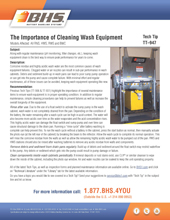We use cookies to make your experience better. To comply with the new e-Privacy directive, we need to ask for your consent to set the cookies. Learn more.
TT-947: The Importance of Cleaning Wash Equipment
Models Affected: All RNS, HWS, RWS and BWC
Along with regular maintenance (pH monitoring, filter changes, etc.), keeping wash equipment clean is the best way to ensure peak performance for years to come.
Description:
Corrosive residue and highly acidic wash water are the most common causes of wash equipment failures. Clogged water or air nozzles can result in sub-par performance in wash cabinets. Debris and sediment build-up in wash pans can lead to poor sump pump operation or can get into the pump and cause complete failure. With minimal effort and regular maintenance, all of these issues can be avoided, keeping wash equipment operating like new.
Recommendation:
Previous Tech Tips (TT-906 & TT-931) highlight the importance of several maintenance items to ensure wash equipment is in proper operating condition. In addition to regular maintenance, simple cleaning procedures can help to prevent failures as well as increase the overall longevity of the equipment.
Rinse after use. Due to the use of a float switch to activate the sump pump in the wash cabinet, wash water is not completely drained from the pan. Depending on the condition of the battery, the water remaining after a wash cycle can be high in acid content. The water will also become more acidic over time as the water evaporates and the acid concentration rises. This highly acidic water can damage the float switch and sump pump and over time can cause structural damage to the drain pan. Running a “rinse cycle” after battery washing is complete can help prevent this. To run the wash cycle without a battery in the cabinet, press the start button as normal, then manually actuate the photo eye (at the left rear of the cabinet) by breaking the beam to the reflector. Allow the wash cycle to complete its normal operation. This will rinse the corrosive residue from the walls as well as allow the remaining highly acidic wash water to be pumped out of the pan. RWS and HWS stations should also be rinsed after washing batteries to remove any acidic residue from walls and components.
Remove debris and sediment from drain pans regularly. Build up of debris and sediment around the float switch may restrict waterflow to the pump. Any debris or sediment which gets into the pump could result in pump damage or failure.
Clean components inside wash cabinets periodically. If mineral deposits or rust stains exist, use CLR® or similar cleanser to wipe down the inside of the cabinet, including the photo eye window. Air and water nozzles can be soaked to keep the unit operating properly.
All of the latest Tech Tips, as well as inspection forms and planned maintenance information are available in the Technical Literature section of our website.
Do you have a topic you would like to see covered in a Tech Tip? Send your suggestions to service@bhs1.com with “Tech Tip” in the subject line and let us know.


